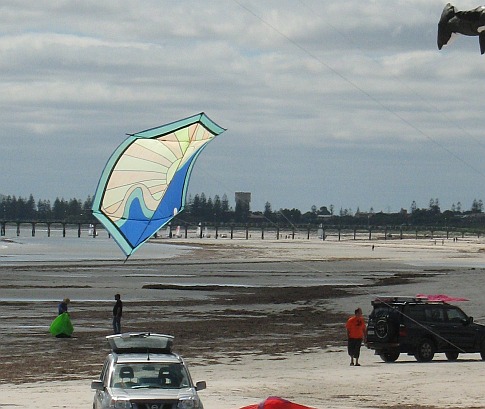- Home Page
- How To Fly
How to Fly a Kite
Fun with One String or Two!
Do you need a hand with knowing how to fly a kite? We've seen plenty of struggling kite flyers from time to time—on the beach, at the park, or near a kite festival in full swing!
Flying a One-String Kite
Any child capable of grasping a string can fly a one-string or single line kite once it has enough height in the air.
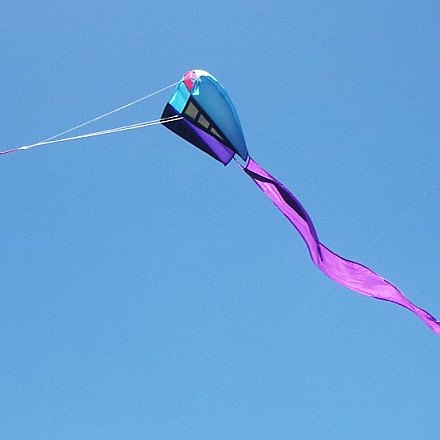 Single-line parafoil
Single-line parafoil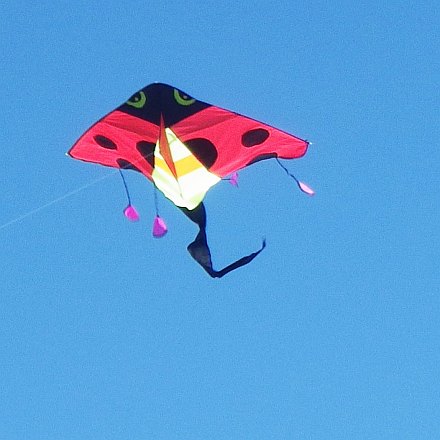 Single-line delta
Single-line delta
What to Fly
To start with, it's hard to go wrong with a store-bought small parafoil like the one in the photo up there. They all have an upper and lower surface, with air intakes at the front. The smallest parafoils can be stuffed into a trouser pocket. Some are sold with the flying line already attached!
The wind inflates the kite into shape for flying.
These kites are so simple to store, transport, and use, it's ridiculous. :-)
If you'd prefer to fly a sticked single-surface kite, try a store-bought delta kite like the one in the other photo up there. They all have that basic triangle shape, and the small- to medium-sized products have a fairly light pull, so any member of the family can hang on.
Here are two nice things about deltas from a beginner's point of view:
- They have a very simple setup. Just insert the rod which spreads the kite flat. That's why it's called the spreader. It's easy to spot the small fitting, on each side of the kite, into which the rod ends are inserted.
- No adjustments are needed, if the kite has a keel—that triangular flap underneath. Just clip or tie the flying line to the eyelet or behind the knot at the point of the keel. Some deltas don't have a keel, having a simple two-leg bridle instead. The bridle should have been adjusted at the factory.
What about tails? For most parafoils or deltas, no tails are necessary. However, these kites are often sold with tails already attached. This is mainly for looks but also helps to settle the kite down in fresh wind.
How to Fly
For the parafoil, once the flying line is attached to the bridle:
- Stand with the wind blowing on your back. The breeze strength always goes up and down, so wait for it to start coming up again.
- Dangle the kite on a short length and let the wind inflate the cells. In a few moments the kite will be ready and will float up by itself.
- While you can feel the kite pulling, slowly let out more line. Just hang on if the kite starts to come down.
It's much the same with the delta:
- Stand with the wind blowing on your back. The breeze strength always goes up and down, so wait for it to start coming up again.
- Dangle the kite on a short length and let the wind catch the sail. Soon, the kite should pop up to a steep angle, perhaps weaving around a little.
- While you can feel the kite pulling, slowly let out more line. Just hang on if the kite starts to come down.
What if the kite just won't stay up?
Don't despair, you can always try a long-line launch with any kite:
- Get a helper to take the kite a long way downwind while you let out line.
- Your helper should hold the kite in a nose-up position, with no slack in the line.
- On your signal (perhaps a thumbs-up) your helper should simply let go of the kite while you pull in the line.
- Keep pulling in line until the kite seems willing to continue climbing on its own.
Easy peasy, lemon squeezy. :-)
What if the kite just loops around continuously?
I've done a whole page on how to make kites fly straight!
Where to Fly
It can be said in two words: the beach.
OK, that's not the only place, but it's the best for your first try with any kite.
You see, particularly when the wind is coming straight off the ocean, the sandy expanse usually results in smoother and more consistent airflow than anywhere else. That's perfect for kites!
But what if you're two day's drive from the nearest coastline? Don't worry; just head for the biggest, most open space you can find.
When flying single liners inland, you will notice two things:
- The breeze strength goes up and down a lot. Timing is everything when launching from your hand.
- Everything gets easier when the kite is far above tree height. At lower altitudes, the kite might descend to the ground quite often during lulls in the wind!
Flying a Two-String Kite
There's a few other different names you might come across with respect to these steerable kites. For example, there's dual-line kites, two-liners, stunt kites, trick kites, foils, sport kites, and multi-liners.
Yes, that's the point of having more than one flying line. You can steer the kite anywhere from way left to way right to nearly overhead. Fun, fun, fun! Just don't fly too close to people or power lines.
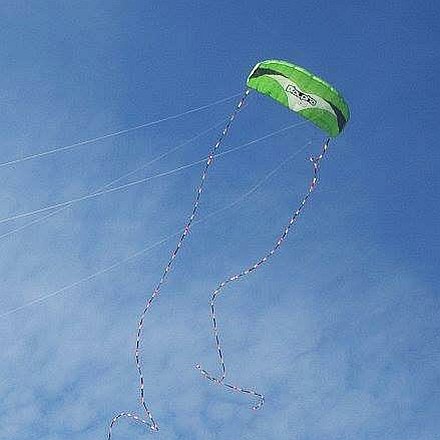 Dual-line parafoil
Dual-line parafoil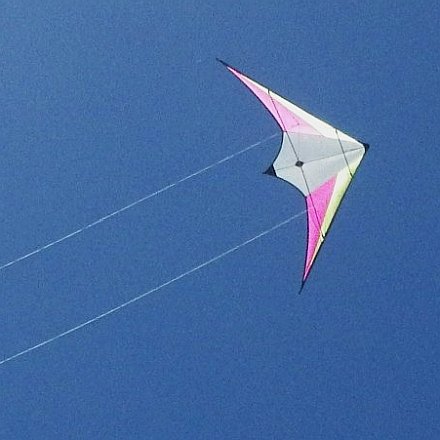 Dual-line delta
Dual-line delta
What to Fly
I'm going to recommend trying a dual-line parafoil first; these are often referred to as soft stunt kites.
Just like the small single-line parafoils, soft stunt kites pack down very conveniently and are simple to set up. These kites also have that double surface but contain many more inflatable cells than tiny single-liners.
The wind inflates the kite into shape for flying. As the kite picks up speed, you will feel the pull increase quite a lot! For this reason, steerable parafoils are not for the very smallest kids. You need to give it a go first, before deciding whether your 5, 8, or 12-year-old child can handle it.
A really good thing about soft stunt kites is that there's nothing to break if it hits the ground hard!
Dual-line deltas, like the one in the other photo up there, take a little more finesse to fly. The beginner models are a heap of fun once you are able to keep them in the air. Although the rigid spars can break in a really bad crash, they are more likely to just pop out of their sockets, which is easily fixed.
For the youngest flyers, the limiting factor is skill rather than strength, since dual-line deltas pull much less than similarly sized parafoils.
What about tails? All steerable kites are more maneuverable without tails, so a long light tail is just for looks. But they can look pretty good, tracing out every move of the kite as it swishes through the air!
How to Fly
It's possible to fly two-line kites on your own. But it's far easier to get a kite in the air with a helper—particularly when you're just starting out!
How to prepare to launch a soft stunt kite:
- Attach the flying lines to the bridles—one on the left and one on the right. Remember which handle goes to which side. :-) Often, one of the handles will be red, so you can remember "Red is on the Right"—foolproof.
- Leave your helper holding the kite as you back away, unwinding the lines from the handles.
- When you have most of the line out, double check that both lines are the same length. If one droops more than the other, take a turn or two onto one handle until the tension seems fairly even.
Here's the launch procedure:
- Stand with the wind blowing on your back. The breeze strength always goes up and down, so wait for it to start coming up again.
- Your helper should hold the kite in a nose-up position, inflated by the breeze and with no slack in the lines.
- On your signal (perhaps a thumbs-up) your helper should release the kite.
- MAKE NO ATTEMPT TO STEER THE KITE for the first second or two, even if it goes off at an angle. However, if it doesn't want to climb you can help it on its way by quickly swinging both hands down and back to your sides—and then hang on for a moment!
- After gaining a bit of height off the ground, you can start experimenting with steering. Pull on the right line to steer right, pull left to steer left. You'll soon get the hang of it. :-)
Doing all this with a dual-line delta is very similar. Of course, the delta doesn't have to inflate, which makes things a little simpler for your helper. Also, you will probably find that less control movement is required to turn the delta once it's flying.
Where to Fly
In my opinion, having flown inland a few times with my Peter Powell steerable diamond and also a dual-line delta, it's just not worth it most of the time. Steerable kites are the most fun low down and that's where the air is most messed up, unfortunately. The lines keep going slack as the breeze drops out from time to time. Even in a fresh breeze, the response from the kite can be chaotic due to turbulence.
Feel free to ignore this advice if you find a truly exceptional flying location. For example, a gentle hill in the middle of a massive square field with hardly a tree or building in sight!
Anyway, you get the picture; for stunt kites of any kind, a smooth onshore breeze down at the beach is the way to go!
Some General Comments
There are some links in here to other pages that expand on related topics. If the weather's bad outside, why not settle in and read here for a while. At least it's all about kites and flying them!
Here's a note about flying shop-bought kites:
If the weather and location are good and the kite is a simple, proven design like a diamond or delta, there shouldn't be much problem. The manufacturer should have set the bridle or keel to give success in most weather conditions.
These kites are generally quite accurately made. Most have a good wind range, meaning they fly in fairly light wind right through to fairly fresh wind.
However, be aware that not all those fancy novelty kites are great fliers!
Wind-Speed Handy Reference
Light Air
1-5 kph
1-3 mph
1-3 knts
Beaufort 1
Light breeze
6–11 kph
4–7 mph
4–6 knts
Beaufort 2
Gentle ...
12–19 kph
8–12 mph
7–10 knts
Beaufort 3
Moderate ...
20–28 kph
13–18 mph
11–16 knts
Beaufort 4
Fresh ...
29–38 kph
19–24 mph
17–21 knts
Beaufort 5
Strong ...
39–49 kph
25–31 mph
22–27 knts
Beaufort 6
High Wind
50-61 kph
32-38 mph
28-33 knts
Beaufort 7
Gale
62-74 kph
39-46 mph
34-40 knts
Beaufort 8
The principles of how to fly a kite aren't any different if it's homemade. However, a whole bunch of things can go wrong if the kite is not made carefully. Also, the smaller the kite, the more accurate you have to be!
Having said that, homemade kites can provide a lot of fun and
reward. Heck, most of this website is all about making your own kite!
The beginning of any flight is the launch. This can be a little tricky when you are on your own, inland, in a gusty variable breeze. I've put together a few tips for this hand launching situation. Since there are some large fields quite close to home, we don't often fly our single liners down at the beach where winds are smoother.
In
good conditions, once you have your kite up high, there really isn't
much to it. Just watch it do its thing. Anchor the line somewhere and
keep an eye on things from time to time while you do something else.
Often, it gets more interesting than just turning up somewhere and
holding a string. So, I've written more on the various situations that
can arise when kite flying with single liners.
But supposing there are problems, for whatever reason. Then it's time to check out a few tips. Maybe someone has fiddled with that bridle adjustment.
Like to see a video clip? Just scroll down to near the end of this page.
How to Fly a Kite
And Not Get Bored
Some, maybe most, people just enjoy the relaxing aspects of flying a single-line kite—just watching it fly, perhaps enjoying the subtle artistry of color and movement. Maybe they even enjoy the feel of controlling an almost-living creature on the end of the line.
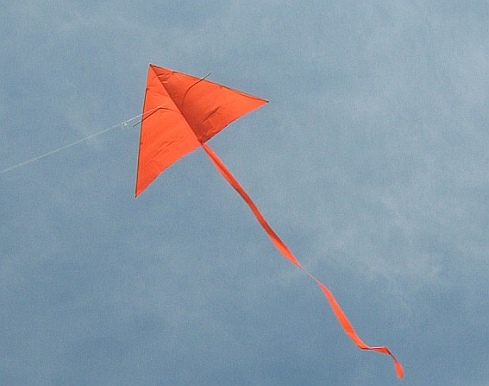 MBK Simple Delta—quick to make, easy to fly in light winds
MBK Simple Delta—quick to make, easy to fly in light windsHowever, if you would like to get a little more out of your kite, why not try the following ideas. No special equipment is needed! OK, maybe you need a stopwatch if you want to get more serious:
- Launch straight off the ground, on a long line. Pull in line to get the kite in the air then let it climb up to full height.
- Bring your kite right down into your hand without letting it touch the ground. Pull in quicker from time to time if needed, to keep it airborne.
- Keep records. See how long you can keep it in the air, to the nearest five minutes.
- See how fast you can get 150 meters (500 feet) of line out, from a hand launch.
- See how quickly you can get the flying line to a 45-degree angle from your hand at maximum length.
- Once you know how to fly a kite, get serious about photographing it from time to time.
Of course, with money, extra gear, and more experience, you can eventually try a range of even cooler things! Like:
- teddy drops or lolly (candy) drops under a simple parachute, using a kite messenger to haul the payload up the kite string
- kite aerial photography (KAP)
- flying really large and artistic kites of various kinds to draw a crowd
- getting involved in kite-fighting competitions with Indian or other fighter designs
- getting serious about making and flying really small kites—requires great craftsmanship and finesse!
That's about it for my somewhat long-winded spiel on how to fly a kite.
Talking about being long winded, here's some more ideas on why you might want to go fly a kite. It's quite a long page!
And just in case you want to know how a kite flies, I've done a piece on that too.
That's our homemade MBK Dowel Delta in the video up there. It's on a very short line, so you can see a bit of detail.



